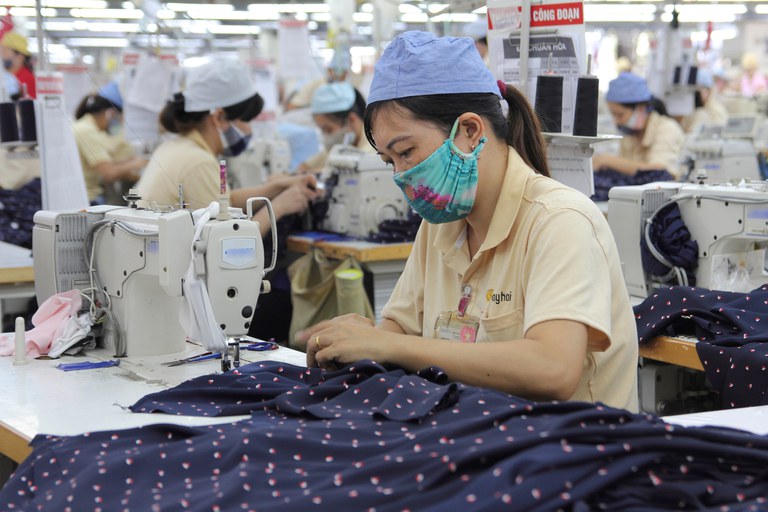Moving the needle on gender equality and decent work in Asia’s garment sector: why and how
Fashion media usually tell us that behind a great woman is a great wardrobe. But what they do not tell us is that behind every piece of clothing in everyone’s wardrobe, there is almost always a woman. Globally, it is estimated that women make up 80 percent of garment workers. Despite their important role, women unequally face a multitude of problems. Female workers lack voice, representation and leadership. They get paid averagely 18.5 percent lower than their male counterparts. At work, they face a greater risk of sexual harassment, bullying and systematic discrimination. At home, they carry more burden of unpaid care work. The COVID-19 pandemic has intensified these gender disparities and left women in the garment industry disproportionately impacted.
These issues have been illustrated in the new report "Moving the needle - gender equality and decent work in Asia's garment sector", produced under the ILO’s Decent Work in Garment Supply Chains Asia project. The report takes a comprehensive look at the challenges women face in the garment and textile industry in Cambodia, Indonesia, Myanmar and Vietnam and examines the status and trends relating to women and gender dynamics in the sector in Asia. Most importantly, it provides a roadmap for action to accelerate progress towards gender equality.
We talk to Joni Simpson, ILO Senior Specialist on Gender Equality and Non-Discrimination and the technical lead of the report, about what we could learn from it. Joining the conversation are Elly Rosita Silaban, President of the Confederation of All Indonesian Trade Unions and Tran Thi Lan Anh, Deputy Secretary General, Bureau for Employer’s Activities, Viet Nam Chamber of Commerce and Industry. Reflecting on the report, the two women leaders share their insight on why it is important that women’s voices are heard and what employers and workers can do to promote gender equality and women’s empowerment.
Q: Elly, you work very closely with female garment workers and have a lot of experience of the challenges they face. Why is it so important that women’s voices are heard?
Elly Rosita Silaban: It is important for women to be able to talk about what is happening in their hearts, including in their professional environment. Issues such as maternity problems and also breastfeeding, miscarriage or psychological problems and their health issues are totally different from men. The low representation and leadership of women at all levels of the sector, results in their voices not being heard. I have often seen men sitting with other men to negotiate collective bargaining agreements but always forgetting the issue of women's rights. So if there are no representative women's voices, how can they achieve anything for their rights?
Q: The COVID-19 pandemic, as we all know, affects businesses and workers incredibly hard around the world. For women garment workers in Asia, what's the impact been?
Joni Simpson: The impact has been detrimental. Much of what we see right now in relation to gender equality is really pre-existing issues that were there before the pandemic. All of these issues are emerging and being further exacerbated. We see that women have been losing jobs more often than men. Because they're in the low-skilled, low paid jobs, they are the first to go. With all of the disruptions in the garment sector, and with it being disproportionate female dominant, this means women are being affected in a higher level.
What else is happening and which is very worrisome is that it will be harder for women to get back to the labour force. This has been documented in previous crises. A lot of the women coming to the garment sector have gone back to their villages when the measures took place and when lockdowns came. We need dedicated actions to make sure that women are able to get back to work. That can be by supporting their unpaid care burdens and making sure that they are aware of the opportunities emerging.
Q: One of the key barriers to women fulfilling their potential in the workplace is the burden they carry relating to unpaid care work and family responsibilities. Lanh Anh, what can employers in the garment sector do to support workers?
Tran Thi Lan Anh: The first thing that should be done is to draw attention to the fact that women carry out disproportionate unpaid care work. Women's work must be in accordance with Convention No. 156 on Workers and Family Responsibility and Convention No. 183 on Maternity Protection. Employers can also promote education and public awareness to challenge and change discriminatory social norms regarding women's and men's roles in unpaid care work.
Employers should work very actively with trade unions on all of these things. In addition, employers can develop policies, actions and investments for accessible and quality care services and decent work for caregivers, and engage in tripartite dialogue involving women workers in the workplace. Employers can connect with the various innovative initiatives with their COVID-19 call to action in the global garment industry and other efforts to expand social protection policies to cover the needs of women, especially those who are informally vulnerable during the COVID-19 pandemic.
Q:The garment industry, as does every other industry, faces challenges regarding violence and harassment in the workplace. What needs to change?
Elly Rosita Silaban: There needs to be more awareness about what constitutes violence and harassment. The understanding of women on violence and harassment is totally wrong for a long time. They only understand that it is violence if it is a rape or if someone touches their body, but they never understand that their supervisor shouting or screaming directly at them also is.
Some women can bring their cases to police or can explain their problem inside the factory to their union. The difficulty is that too many workers do not join unions. When they face sexual violence inside the factory, they refuse to bring it to the management because they believe that men will dismiss them, that people will not believe them or that police will ask and then maybe blame them. Unions can teach them how to speak up and how to defend their rights.
Q: Lan Anh, let's talk about money now. The report shows that female garment workers are generally paid less than their male counterparts, why is this and what needs to be done?
Tran Thi Lan Anh: From the report we can see that the first important factor in gender pay gap is the under valuation of women's work in labour-intensive occupations and that in the garment sector, the concentration of women is at very low and very end of the global supply chains.
In order to close the pay gap, the employer should prioritize the attention to comply with the national law and the Convention 100 and the SDG 8.5. Together with the trade union and the government, employers should strengthen, monitor and enforce the national policies and enlarge on equal pay for a work of equal value as well as a minimum wage levels in line with international commitments and guidance from international labour standards. In addition, the employer should ensure that the female workers at the workplace can represent and have a leadership role in initiatives and social dialogue to protect their rights and protect the equality in pay and also the minimum wage levels. Finally, at the company level, employer should review and adjust hiring and promotion policies to make sure that the wage and salary system is identified and complied.
Q: Change is constant in the global garment sector, and for workers and firms in Asia, technological advances and shifting consumer and customer habits are an ever-present consideration. How can workers and particularly women workers be part of shaping and benefiting these changes rather than suffering from their impact?
Joni Simpson: Women workers can be active agents for change in the sector in particular when policies address their needs and when workplaces uphold decent working conditions. So much more can be done and should be done to ensure that women can and do take up leadership roles, and this can be through policy measures that create a more gender responsive workplace. It can be by ensuring women can take up capacity development opportunities in this current time to upskill. We'd like to see them taking on those more higher skilled, higher paying jobs, not only for their benefit but also for the benefit of enterprises. Because when we have diversity and a more balanced workforce on all levels, we know that leads to better decision making. It leads to better innovation at the company level.
What we see through the report is that there are a lot of good initiatives and policies out there. But what we also see is that ad hoc interventions rarely lead to sustainable and transformative change and the status quo certainly won't lead to that change either. So I wanted to focus on one of the 'P's within the report which is on ‘Progress’- how to make progress on moving the needle on gender equality. We can sum it up to with being intentional. Each of us has a sphere of influence, a responsibility, an ability to do our part to ensure that women don't fall further behind during the COVID crisis and beyond.
Learn more about the current status and trends relating to women and gender dynamics in Asia’s garment sector from the recent report “Moving the needle - gender equality and decent work in Asia's garment sector", a product of the ILO’s Decent Work in Garment Supply Chains Asia project.

